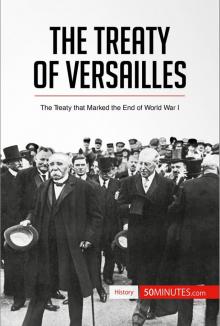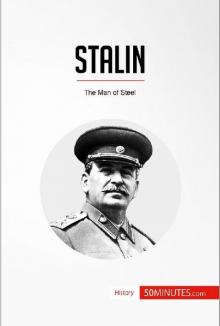- Home
- 50MINUTES. COM,
The Treaty of Versailles
The Treaty of Versailles Read online
The Treaty of Versailles
Key information
When: 18 January 1919 – 10 January 1920.
Where: Paris.
Context:End of World War I (1914-1918).
The signing of the Armistice (11 November 1918).
Key protagonists:Georges Clemenceau, French Prime Minister (1841-1929).
Thomas Woodrow Wilson, US President (1856-1924).
Vittorio Orlando, Italian Prime Minister (1860-1952).
David Lloyd George, British Prime Minister (1863-1945).
Impact:The creation of the League of Nations in 1919.
Rivalry between the European Allies.
The weakening of the great Western powers.
The rise of nationalism.
Introduction
The Treaty of Versailles marked the end of the First World War between Germany and the Allies, represented by Georges Clemenceau (France), David Lloyd George (Great Britain), Woodrow Wilson (United States) and Vittorio Orlando (Italy). It was signed on 28 June 1919 in the Hall of Mirrors at the Palace of Versailles, the same place where the proclamation of the German Empire had taken place in 1871. By imposing this location on Germany, France wanted to symbolically rid itself of the humiliation endured during the Franco-Prussian War in 1870 by forcing Germany to recognise its responsibilities in the world war.
The terms of the treaty were severe towards the defeated country. An eighth of Germany’s territory was annexed and they were forced to give up their colonies to the victors. In addition, they had to give Alsace-Lorraine back to France and pay a heavy fine for damages caused during the war. The treaty also stipulated the abolition of military service, reducing the German army to 100 000 men, in the aim of limiting its power. In order to ensure that the many terms were respected, the Allies planned to occupy the left bank of the Rhine for 15 years.
The German delegates eventually signed the document, which was viewed in Berlin as a humiliating and hostile diktat imposed by the victors. In the end, the treaty was a diplomatic failure. It stirred up rivalries among European powers, anxious to maintain their standing, to the detriment of a damaged Germany, where the seeds of the Second World War were already being sown.
Context
Europe under German domination
Assassination of Archduke Franz Ferdinand of Austria.
On 28 June 1914, Archduke Franz Ferdinand of Austria (1863-1914) and his wife were shot by the Serb anarchist Gavrilo Princip (1894-1918) in Sarajevo. The European states used this pretext to declare war on each other. On 4 August 1914, the German general Helmuth von Moltke (1848-1916) sent his army towards Paris. He was counting on a quick victory against France, but the resistance mounted by Belgium, then by France, stopped the German advance in its tracks on the banks of the Marne.
The winter of 1914 saw the armies stuck in a war of attrition. For many months, they faced each other on either side of a front line that was over 400 miles long, without any offensive action by either of the warring countries giving an advantage to one side or other. At the beginning of 1918, the situation was critical for the Allies: after four years of fighting, the German Empire dominated Europe, had managed to keep its army intact and had successfully protected its territory from invasion.
On 3 March 1918, the Treaty of Brest-Litovsk (Belarus), a separate peace treaty signed with the Soviets, guaranteed Germany victory in the East. The German general Erich Ludendorff (1865-1937) seized the opportunity to reinforce his troops on the Western front. There he launched three offensives: one in Picardy (21 March), one in Flanders (9 April), then one on the Chemin des Dames (27 May). These operations nearly brought victory to the Germans, who managed to advance 40 miles on the Allied front, reaching Amiens and even threatening Paris in June. However, the resistance mounted by the British and French armies at the Second Battle of the Marne, which lasted from 15 to 20 July 1918, revealed the enemy army’s weaknesses and forced them to retreat to the Department of Aisne on 18 July. This was the start of Germany’s decline.
The intervention of the United States
President Wilson asking Congress to declare war on Germany.
The US joined the war in April 1917, and President Woodrow Wilson hoped for a quick victory against the Second Reich, without eliminating it completely. On 8 January 1918, he presented his “Fourteen Points” to the United States Congress, which set out the necessary conditions for re-establishing peace among the European states following the war. These included the abolition of secret diplomacy, limits on weaponry and the creation of a League of Nations, tasked with ensuring the territorial integrity and sovereignty of the European states.
The American president’s objective was pragmatic. He wanted to persuade the two blocs of the need to reach a balanced peace agreement without annexation, based on the principle of people’s right to self-determination. Initially, the move was a failure. At the beginning of 1918, the military offensives launched in the Somme to destabilise the German front prevented the diplomatic resolution of the conflict. At this stage in the war, Wilson realised that peace was only attainable with the intervention of the American army to allow the balance of power to be reversed in favour of the Allies.
Indeed, after only just managing not to collapse during the German offensives between March and April, the French army had lost all ability to launch major offensives. The position of the British was no more enviable; they were mourning the loss of 236 000 men.
On 26 March 1918, Georges Clemenceau placed the Allied forces situated on the Western front under the sole command of Marshal Ferdinand Foch (1851-1929). On 27 May, the new Allied generalissimo contacted John Pershing (1860-1948), commander of the American Expeditionary Force, to convince him to take part in a general offensive against Germany. But Pershing had just arrived in France with an army corps of just 14 500 men. After lengthy negotiations, Congress agreed to send him a million soldiers who had been mobilised by the Selective Service Act, a law that had enabled conscription in the United States since May 1917.
Reassured by the Americans’ participation, Foch launched a joint Allied offensive in the Department of the Somme on 8 August 1918. Although only acting as reinforcement, the presence of three million American soldiers in Europe weighed the conflict decisively in favour of the Allies.
Approaching the Armistice
By virtue of now having higher numbers of men and artillery, the British managed to break through German lines in Picardy, Artois and Flanders at the end of September. Now in complete disarray, the Prussians were faced with the collapse of their allies in Eastern Europe.
Forced to retreat on all fronts, General Ludendorff advised Wilhelm II (King of Prussia and German Emperor, 1859-1941) to surrender. On 3 October 1918, the Emperor sent Prince Maximilian of Baden (German politician, 1867-1929) to ask President Wilson for peace.
The Reich thus found itself on the brink of collapse. In Berlin, far-left political factions exploited the population’s unhappiness to organise strikes against the “imperialist war” and set up workers’ councils (soviets), thus following the example set by the Russian revolutions. Now powerless, Wilhelm II abdicated on 9 November. The next day, the Reichstag (parliamentary assembly of the German Empire) announced it was becoming a Republic. In the meantime, a delegation, led by Matthias Erzberger (German politician, 1875-1921) crossed the French front lines to negotiate the terms of an armistice. The discussions began on 8 November in Marshal Foch’s personal train carriage. Taking advantage of the Germans’ defeat, the Allied leader imposed surrender with draconian conditions upon them. They had to accept the liberation of Allied prisoners of war and leave territories they had invaded in the
West, notably Alsace-Lorraine, within a fortnight.
Signed on 11 November 1918, the Armistice put an end to four years of armed fighting on the European continent. The conditions were then met for the imposition of a peace treaty dominated by France’s interests and desires for revenge over a defeated Germany. But the events to come would show that victory does not necessarily guarantee peace.
Biographies
George Clemenceau, the father of French victory
Georges Clemenceau.
Born in 1841, Georges Clemenceau was the head of the radical left before 1914. When France went to war, his anti-German sentiment incited him to call the French to sacrifice anything to triumph over Germany. Consequently, when Raymond Poincaré (French statesman, 1860-1934) called him to government in November 1917 as the conflict was at a critical stage, his only declaration to the French National Assembly was “I’m going to war!” Supported by a large parliamentary majority, he implemented a policy of public safety and castigated defeatists. To him, war could only lead to victory.
Following the Armistice, the French nicknamed him the “Father of Victory”. It was therefore no surprise that he represented France at the peace talks aimed at regaining Alsace-Lorraine, safeguarding the border between France and Germany and securing war reparations from Germany. Clemenceau in fact hoped to force Germany to recognise the destruction inflicted on France. Nonetheless, he admitted that his country was not the only one that could boast of having played a part in the victory. Without its allies, France would have certainly been defeated. He therefore had to restrain himself and eventually accepted the creation of the League of Nations.
Elected as leader of the National Bloc (a centre-right coalition) in 1919, the supporters of Action Française (a far-right French political movement) reproached him for not being strict enough in the enforcement of the treaty.
In January 1920, he sought the presidency of the Republic, from where he hoped to monitor the implementation of peace treaties. But his defeat by Paul Deschanel (French statesman, 1855-1922) signalled the end of his political career. He spent the rest of his life largely alone, making the most of his free time for travelling and writing.
He died in Paris on 24 November 1929.
Thomas Woodrow Wilson, the idealist
Picture of Thomas Woodrow Wilson.
Born in 1856, Thomas Woodrow Wilson was elected to the White House in 1912. A true pacifist, he proclaimed the United States’ neutrality in 1914, thus limiting their involvement in the war to international cooperation.
But faced with the submarine war that Germany declared on the US in January 1917, he could no longer stay silent and had his country join the war in April. Wilson saw it as the opportunity to convert the world to democracy. On 18 November 1918, when he announced that he would be attending the peace talks, everyone was stunned. No president in office had ever previously represented the United States abroad.
When he arrived in Paris on 14 December, he tried to ensure that the peace treaty would be signed without any annexations. Wilson, in fact, wanted Germany to regain its powerful position without too much frustration, so that peace would be guaranteed in the long term. But Clemenceau did not share this opinion. The Frenchman believed that the creation of a buffer state (Territory of the Saar Basin and the Ruhr), occupied by the French army, was the condition for avoiding another war by reducing Germany’s power. Unfortunately for Wilson, his ideals turned out to be incompatible with this aggressive European diplomacy.
Despite this initial failure, he was determined to fight for his convictions. The issue was now to get the Treaty of Versailles past Congress, particularly the creation of a League of Nations. In July 1919, he organised a propaganda campaign across the United States, which exhausted him. Immobilised by his declining health, he continued to fight from his bed, and demanded the adoption of the treaty in its current form, but the Senators refused to ratify it.
His policies, which aimed to pull the United States out of isolationism, were not successful. In 1920, he sought a third term, but the Americans chose the Republican Warren G. Harding (1865-1923), who offered a return to normal life after the war.
On 20 November 1919, Wilson received the Nobel Peace Prize for his actions during World War I. Two years later, he retired from the political scene and passed away on 3 February 1924 in Washington.
David Lloyd George, the British lion
Picture of David Lloyd George.
Born in 1863, Lloyd George dominated British political life between 1906 and 1922. Initially opposed to Great Britain joining the war, from 1915 he developed the weapons industries necessary to the war effort and supported the policy of great offensives, notably the Dardanelles Campaign.
In December 1916, he replaced Herbert Asquith (1852-1928) as Prime Minister and led Great Britain to victory in the war. Additionally, his position allowed him to negotiate with the Americans and the French in Paris.
While he initially believed that Germany should pay for the damages caused, he ended up adopting the same positions as Wilson. Convinced that they would regain some of their power, he insisted on the importance of not humiliating them, out of fear of losing an essential partner for Great Britain. As for the League of Nations, he saw a way of involving the United States in Europe’s affairs. When he returned to London, he hastened to have the treaty ratified, for fear that the House of Commons or House of Lords would refuse it, at the risk of delaying essential reforms for the country’s economic recovery.
In 1922, the carelessness of his anti-Turkish policy in the Chanak Crisis (September-October 1922) caused him to lose power. Once again leader of the Liberal opposition in the Commons, he witnessed the break-up of his party. Increasingly isolated on the British political scene, he nonetheless did not lose his influence. With the help of the economist John Maynard Keynes (1883-1946), he began a reform project to turn Great Britain into a welfare state.
The Chanak diplomatic crisis
The Chanak Crisis was the first major test of Lloyd George’s foreign policy towards Turkey, led by Mustafa Kemal Atatürk (Turkish president, 1881-1938). In complete disregard of the Treaty of Sèvres, Turkish nationalist troops attacked the Greeks in Asia Minor and besieged the occupying British forces in the small seaport of Chanak during the summer of 1922. Afraid of seeing the Turks threaten the British army in Constantinople, Lloyd George ordered the military forces of the Dominions to send troops to show the Empire’s solidarity facing Turkey. Kept relatively in the dark about these manoeuvres, Parliament stated that this policy was careless and called for the Prime Minister’s resignation. But the crisis was eventually resolved thanks to French intervention, which led to the Armistice of Mudanya on 11 October 1922.
In the 1930s, Lloyd George found it difficult to take a position on the rise of the Nazi party. In 1936, he even went to Berlin to meet Hitler (German chancellor, 1889-1945), who was happy to greet “the man who had won the war”. But two years later, the Anschluss (the annexation of Austria by Germany) caused him to assess the powerlessness of Neville Chamberlain’s government concerning the Third Reich’s military redeployment. In 1940, in the House of Commons, he gave a historic speech that would strip Chamberlain of his title as Prime Minister, to be immediately replaced by Winston Churchill. The latter offered Lloyd George a position in his Cabinet, but he refused.
He spent his last years defending the consolidation of the welfare state, which he himself had initiated, and called for a calculated peace negotiation with Germany after the Battle of Britain (August-October 1940).
He died on 26 March 1945 in London.
Vittorio Orlando, the sidelined victor
Vittorio Orlando.
Born in Palermo in 1860, Vittorio Emanuele Orlando was a moderate liberal member of parliament. From 1897, he worked alongside the head of the Italian Council of State, Giovanni Giolitti (1842-1928), as the Minister of Education (1903-1905), the
n the Minister of Justice (1907-1909). Between 1914 and 1916, he was entrusted this ministry again in the government of Antonio Salandra (Italian politician, 1853-1931).
Following Italy’s defeat at the Battle of Caporetto (24 October-9 November 1917), he led the formation of a national union guided by the idea of resistance. He developed the economy energetically and reinforced the country’s military strength, which would ensure the defeat of the Austrians at the Battle of Vittorio Veneto (October 1918).
In 1919, he chaired the Paris Peace Conference to ensure that the stipulations of the 1915 Treaty of London, which stated that unredeemed land would be returned to Italy in exchange for its commitment to the forces of the Triple Entente, were being respected. But when the time came, the Allies refused to honour their commitment, fearing that Italy would become too powerful in the Mediterranean. At a dead end, Vittorio Orlando decided to send Italian troops to Antalya (Turkey) and station them around Smyrna (modern-day Izmir), to force the French and British to give him control of the port of Rijeka (Croatia) at the expense of Yugoslavia. But this manoeuvre weakened him, and he left the negotiating table on 19 June 1919.
When he returned to Rome, he was elected as leader of the Assembly. He quickly attracted much criticism from the Italians, who reproached him for not having been able to act in the interests of the country among the Allies and therefore having failed to secure compensation for the sacrifices made during the war.
Italy at that moment experienced a serious crisis, which stirred opposition between the trade unions and members of management, brought together within the new National Fascist Party led by Mussolini (1883-1945). Although Orlando initially supported Mussolini, who obtained power by force, he ended up joining the opposition when the fascists assassinated the leader of the Socialist party, Giacomo Matteotti (1885-1924), on 10 June 1924.

 Break Free of Your Depression
Break Free of Your Depression The Treaty of Versailles
The Treaty of Versailles Effective Delegation
Effective Delegation Stalin: The Man of Steel (History)
Stalin: The Man of Steel (History)